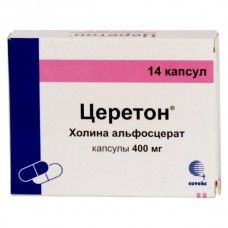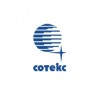Expiration date: 12/2026
Description pharmaceutical form:
The solution for the on/in and/m introduction: clear, colorless liquid.
Capsules: soft gelatin oval shape, yellow or yellow with a light brown tint. The contents of capsules — oily, clear, colorless or slightly colored liquid.
Pharmacokinetics:
For parenteral doses (10 mg/kg), Cereton predominantly accumulates in the brain, lungs and liver. Absorption is 88%. Easily permeates through GEB (in oral administration, the concentration in the brain — 45% of that in plasma), 85% of the excreted light in the form of carbon dioxide, the remainder (15%) is excreted by the kidneys and through the intestines.
Description pharmacological action:
Nootropic agent. Central holinostimulyator, which contains 40, 5% metabolically protected choline. Metabolic protection promotes the release of choline in the brain. Provides a synthesis of acetylcholine and phosphatidylcholine in neuronal membranes, improves blood flow and enhances the metabolic processes in the Central nervous system activates the reticular formation. Increases the linear velocity on the side of traumatic brain damage, contributes to the normalization of spatio-temporal characteristics of spontaneous brain activity, regression of focal neurological symptoms and recovery of consciousness has a positive effect on cognitive and behavioral responses of patients with vascular diseases of the brain (dyscirculatory encephalopathy and residual effects of cerebrovascular accident). Preventive and corrective effect on the pathogenetic factors involutional psychoorganic syndrome alters the phospholipid composition of neuronal membranes and increases cholinergic activity. Stimulates dose-dependent release of acetylcholine in physiological conditions, participating in the synthesis of phosphatidylcholine (membrane phospholipid), enhances synaptic transmission, neuronal plasticity membrane receptor function. Has no effect on the reproductive cycle and is not teratogenic, mutagenic effect.
Indications:
- acute and recovery periods of severe TBI and ischemic stroke, the recovery period hemorrhagic stroke occurring with focal hemispheric symptoms or symptoms of brain stem
- psychoorganic syndrome on the background of degenerative and involutional changes in the brain
- cognitive disorders (disorders of cognitive function, memory, confusion, disorientation, decreased motivation, initiative and ability to concentrate), including in dementia and encephalopathy
- senile psevdomelanjolia.
Contraindications:
- The solution for the on/in and/m introduction
- hypersensitivity to the drug
- pregnancy
- the period of breastfeeding.
Capsules
- hypersensitivity to the drug
- in the acute stage of hemorrhagic stroke
- pregnancy
- breastfeeding
- children under 18 years of age (due to lack of data).
Side effects:
May cause nausea (mainly as a result dopaminergic activation), in this case reducing the dose of the drug.
Allergic reactions.
Drug interactions:
Significant interactions with other drugs have not been identified.
Method of application and dose:
The solution for the on/in and/m introduction: in/in, in/m. in acute conditions, give/in the (slow) or/m 1000 mg/day (1 amp.) within 10-15 days.
Capsule: inside. During the recovery period of brain injury, ischemic or hemorrhagic stroke — 800 mg morning and 400 mg a day for 6 months.
In chronic cerebrovascular insufficiency and dementia syndromes — 400 mg (1 caps.) 3 times a day, preferably after meals, for 3-6 months.
Overdose:
Symptoms may be nausea.
Treatment: symptomatic therapy.
Special instructions:
Cereton, has no effect on the speed psychomotor reactions.





